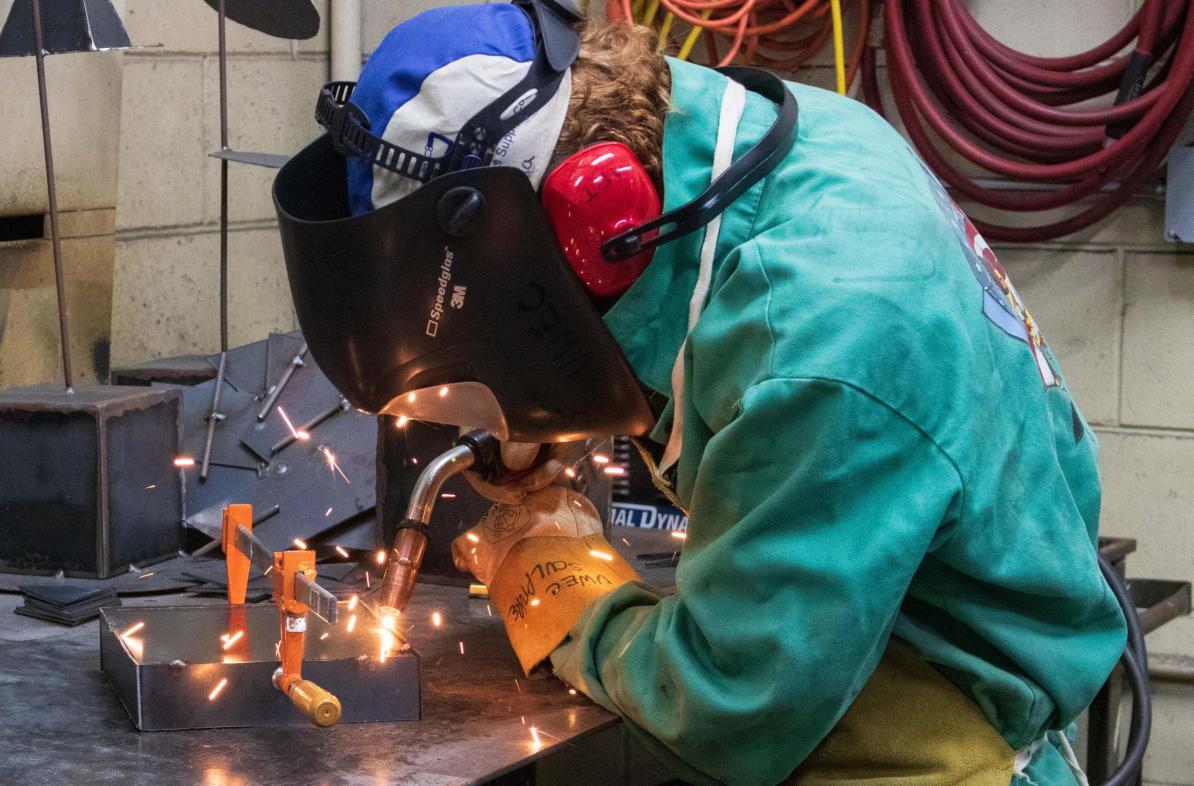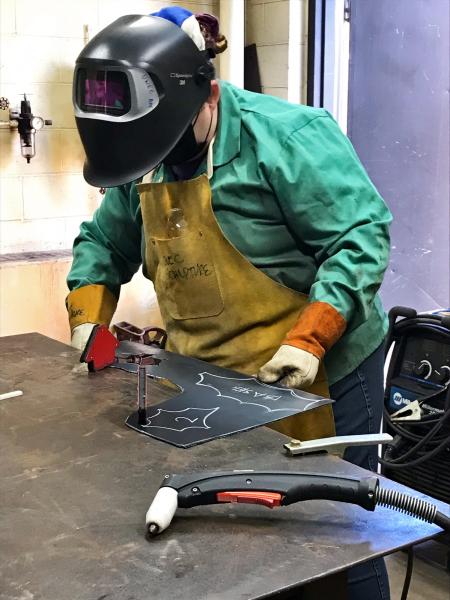
Art students collaborate with local business on welding project
As Brittany Harp puts the finishing touches on her metal sculpture — a creation made with shapes and colors to represent the sun — the University of Wisconsin-Eau Claire senior knows she’s taking more from the welding project than a piece of art.
She’s also taking new skills and experiences that will help her in her future career in art education or art therapy, says Harp, who graduated in May with a major in studio art, a minor in psychology and a certificate in American Sign Language.

UW-Eau Claire student Brittany Harp prepares to weld pieces of her metal sculpture she created in an art class. (Contributed photo)
“I didn’t know anything about welding when I started,” says Harp, who completed the project this spring in an intermediate sculpture course. “It was fun to go into the welding room knowing nothing and to come out with this giant piece.”
The lengthy creative process involved turning her idea into a drawing, then into a model — or in her case, three models — and then scaling it to the actual full-size piece of art. The final step involved painting the sculpture with the help of an Eau Claire business, Eclipse Powder Coating.
Harp says each step in the project was interesting, but having the opportunity to professionally paint her sculpture at a local business made the welding project an “over the top” experience.
“We could have just stopped at the welding, but instead we had an experience we couldn’t have on campus,” Harp says of spending a recent Saturday at Eclipse learning how to do powder coating, a painting process that keeps metal from rusting when it’s out in the elements.
The partnership with Eclipse has been a “wonderful experience” that gives students additional high-impact learning experiences, which they will carry with them beyond the classroom, says Cedar Marie, an assistant professor of sculpture who teaches the intermediate sculpture course.
“I want students to have meaningful experiences that get them off campus and interacting with others in the community,” Marie says. “It’s not just about what they’re learning in the classroom but taking the knowledge and skills they’re learning and experiencing and applying it to whatever they do in the world. It isn’t just about being able to put two pieces of metal together; it’s a process of solving a problem through creative means.”
The art of welding
People are constantly surrounded by welded components, such as the beams that support buildings and bridges, Marie says. Welding also is used in creative projects, including things like using metal to create beautiful yet functional pieces of furniture, she says.
So, given its relevance, Marie says it’s important that welding be part of the university’s art curriculum.
With that in mind, the final project in her intermediate sculpture course is a metal sculpture project. Students choose a theme for a geometric abstract sculpture, and Marie gives them basic parameters as well as the materials they’ll need to complete their welding project.
She asks students to approach their work as if they are professional artists who’ve been commissioned to create a sculpture. Over eight weeks, they take their idea from a concept to a finished piece of art that they can hang on a wall or place in a garden. As they would for a commissioned piece, they must document and share every step of their creative process.
“The whole process takes a long time, but I want them to walk away with a holistic understanding of creating a sculpture that could have a life outside of the classroom,” Marie says. “They may never again weld, but what they take away from the practice of welding are things that will help them in whatever they choose to do in the future.”
Community connections
While there is a metals area on campus, the university currently doesn’t have the equipment nor the space necessary for bigger welding projects, Marie says. So, she’s working to build connections with the local business community to see how it might help her create new welding opportunities for her students.
When Marie reached out to Eclipse, the business was eager to share its expertise, facility and materials with her students at no cost.
As students finished the classroom portion on the project, they toured Eclipse, learning how the business operates and about the services it offers. They returned a couple days later to work alongside Eclipse employees to powder coat their sculptures, which was the final step in their welding projects.
Tom Hagenbucher, Eclipse’s business development manager, says the business is excited to work directly with UW-Eau Claire art students.
“We teach them the whole process,” Hagenbucher says. “A lot of these students had no idea what powder coating even is, so we had a blast showing them what we do.”
Hagenbucher says the partnership is a “win-win for everybody” because students leave with a painted metal sculpture and an understanding of how powder coating can enhance their art, and Eclipse benefits because more people know about their business and services.
Learning from and about a local business is an experience he didn’t expect to find in a sculpture class, says Nicholas Bubolz, whose sculpture was inspired by a Japanese print featuring a giant tsunami wave. He used metal to create wave forms, adding metal rods across the piece to “make it interesting.”
At Eclipse, he enjoyed learning how to powder coat his sculpture, but he also was fascinated by the company’s business model and how it efficiently meets client needs, says Bubolz, who graduated this month with a major in information systems, and minors in art and computer science. The visit helped him see that art and business are more similar than people often think.
“I find the creative process of developing an art project, getting feedback and then doing it from start to finish interesting,” Bubolz says. “I realized that in many ways, the process is like establishing and running a business. This was a great opportunity to see business and art come together.”
Looking ahead
Marie’s relationship with Eclipse began just before COVID-19, so this spring was only the second time her students visited the business. Her hope, she says, is that it will be a long-standing partnership that will help the university’s welding program continue to grow.
In the future, Marie hopes the welding program will grow in ways that will allow students to give back to the campus and community through their artwork. For example, with the right equipment and space, students could create items like “functional but colorful bike racks that will help make the campus really fun.” They also could create public art pieces for the community, including sculptures that could potentially be part of the Eau Claire sculpture tour.
“We live in a built environment,” Marie says. “Anywhere you look, there is some kind of welded component; it’s prevalent and important. It supports us as human beings. Our focus is art, so we’re thinking about the many things we can do with welding in a sculpture course. We are working with what we have as far as equipment and space, but our goal is to continue building our resources on campus and with community partners.”
You may also like


